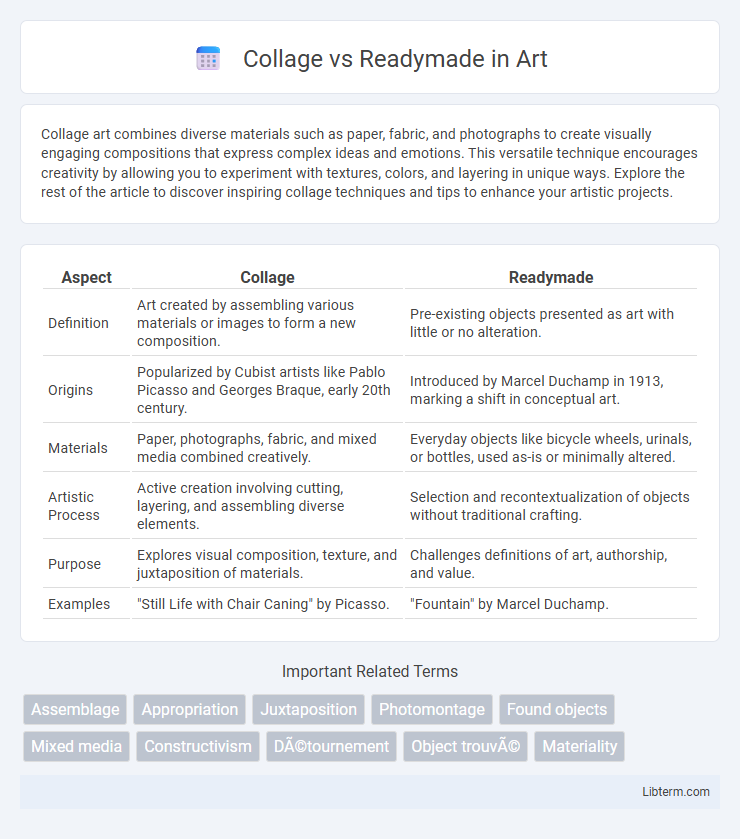Collage art combines diverse materials such as paper, fabric, and photographs to create visually engaging compositions that express complex ideas and emotions. This versatile technique encourages creativity by allowing you to experiment with textures, colors, and layering in unique ways. Explore the rest of the article to discover inspiring collage techniques and tips to enhance your artistic projects.
Table of Comparison
| Aspect | Collage | Readymade |
|---|---|---|
| Definition | Art created by assembling various materials or images to form a new composition. | Pre-existing objects presented as art with little or no alteration. |
| Origins | Popularized by Cubist artists like Pablo Picasso and Georges Braque, early 20th century. | Introduced by Marcel Duchamp in 1913, marking a shift in conceptual art. |
| Materials | Paper, photographs, fabric, and mixed media combined creatively. | Everyday objects like bicycle wheels, urinals, or bottles, used as-is or minimally altered. |
| Artistic Process | Active creation involving cutting, layering, and assembling diverse elements. | Selection and recontextualization of objects without traditional crafting. |
| Purpose | Explores visual composition, texture, and juxtaposition of materials. | Challenges definitions of art, authorship, and value. |
| Examples | "Still Life with Chair Caning" by Picasso. | "Fountain" by Marcel Duchamp. |
Introduction to Collage and Readymade
Collage is an art technique that involves assembling various materials such as paper, photographs, fabric, and other found objects onto a surface to create a unified composition. Readymade art, pioneered by Marcel Duchamp, transforms everyday manufactured objects into artworks by presenting them in new contexts without alteration. Both approaches challenge traditional definitions of art by emphasizing assemblage and conceptual reinterpretation over conventional craftsmanship.
Defining Collage: History and Techniques
Collage, an art form originating in the early 20th century with pioneers like Picasso and Braque, involves assembling diverse materials such as paper, fabric, and photographs onto a single surface to create a unified composition. Techniques include cutting, layering, and pasting various textures and images to produce abstract or representational works, emphasizing contrast and juxtaposition. This method contrasts with readymade art, which repurposes everyday objects with minimal alteration, highlighting the creative process of collage as a deliberate act of composition and integration.
Understanding Readymade: Origins and Concepts
Readymade art originated with Marcel Duchamp in the early 20th century, revolutionizing traditional art by presenting everyday objects as artworks without modification. This concept challenges conventional notions of creativity and authorship by emphasizing the artist's choice and context over craftsmanship. Understanding readymades involves recognizing their role in questioning aesthetic values and the boundaries between art and ordinary objects.
Key Artists in Collage and Readymade Movements
Key artists in the collage movement include Pablo Picasso and Georges Braque, who pioneered Cubist collage techniques by integrating paper and fabric into their compositions. Marcel Duchamp is the central figure in the readymade movement, famously transforming everyday objects like a bicycle wheel and a urinal into provocative art pieces that challenged traditional aesthetics. Hannah Hoch also contributed significantly to collage, particularly in Dada, by using photomontage to critique social issues.
Materials and Methods: Collage vs Readymade
Collage uses a variety of materials such as paper, fabric, photographs, and found objects layered or assembled to create new compositions, emphasizing texture and juxtaposition. Readymade art involves selecting and presenting everyday manufactured objects, like a bicycle wheel or a urinal, without alteration, challenging traditional notions of craftsmanship and artistic creation. The methods in collage rely on cutting, gluing, and assembling diverse elements, while readymades focus on context and selection to redefine ordinary items as art.
Artistic Intent: Personal Expression vs Appropriation
Collage emphasizes artistic intent through personal expression, allowing artists to combine diverse materials and images to convey unique narratives and emotions, reflecting their individual perspectives. Readymade art challenges traditional notions by appropriating ordinary objects, shifting focus to concept over craftsmanship and prompting viewers to reconsider context and meaning. This contrast highlights collage as a personalized creative process, whereas readymades provoke discourse on the boundaries of art and originality.
Impact on Modern and Contemporary Art
Collage revolutionized modern and contemporary art by introducing new dimensions of texture, depth, and narrative through the combination of diverse materials and imagery, exemplified by Picasso and Braque's Cubist works. Readymade art, pioneered by Marcel Duchamp, challenged traditional notions of creativity and authorship by elevating ordinary manufactured objects to the status of art, prompting critical discourse on artistic value and originality. Both practices significantly influenced movements such as Dada, Surrealism, and Pop Art, reshaping artistic expression and expanding the boundaries of visual culture.
Audience Perception: Interactivity and Interpretation
Collage engages the audience through layered visuals that invite active interpretation, encouraging viewers to piece together meaning from disparate elements. Readymade art challenges traditional art perceptions by presenting everyday objects, prompting audiences to reconsider the context and value of ordinary items. Both forms foster interactive experiences, but collage relies on synthesis and personalization, while readymade emphasizes conceptual recontextualization.
Practical Applications in Today’s Art World
Collage integrates diverse materials such as paper, fabric, and photographs to create layered visual narratives, widely used in contemporary mixed media art and digital design for advertising and editorial projects. Readymade art repurposes everyday objects as finished artworks, challenging traditional art concepts and influential in installations, conceptual art, and cultural commentary. Both practices shape modern artistic expression by blending originality with familiar contexts, driving innovation in gallery exhibitions, commercial art, and public art interventions.
Conclusion: Choosing Between Collage and Readymade
Choosing between collage and readymade art depends on the artist's intent and desired expression; collage allows for intricate layering and personal storytelling through assembled imagery, while readymade emphasizes conceptual value by repurposing ordinary objects. Both methods challenge traditional art definitions but cater to different creative processes--collage offers hands-on manipulation, whereas readymade relies on context and originality of presentation. The decision ultimately hinges on the emphasis placed on craftsmanship versus conceptual impact within the artwork.
Collage Infographic

 libterm.com
libterm.com